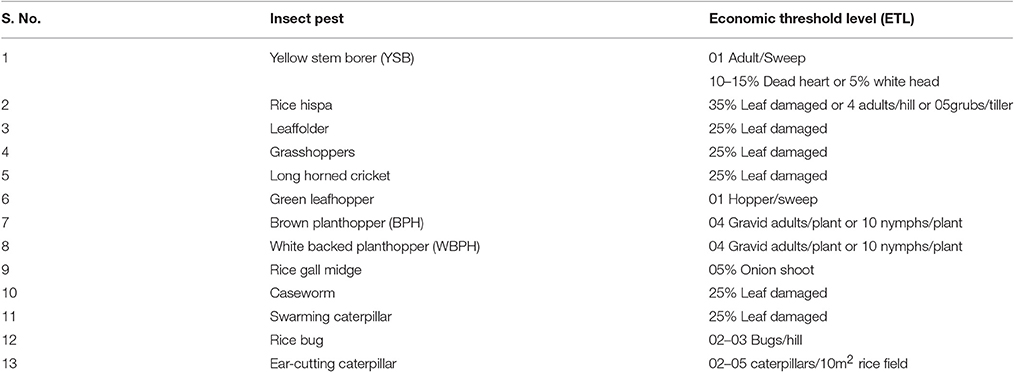Rice Production without Insecticide in Smallholder Farmer's Field
- 1Entomology Division, Bangladesh Rice Research Institute, Gazipur, Bangladesh
- 2Rice Farming Systems Division, Bangladesh Rice Research Institute, Gazipur, Bangladesh
- 3United States Department of Agriculture, Agricultural Research Service, Southern Insect Management Research Unit, Stoneville, MS, USA
Highlights:
• Use of perching, sweeping, and need based insecticide (IPM technique) useage produce at par yields compared to prophylactic insecticide useage in rice fields.
• There exists a technique that can reduce 75% of insecticide useage in rice field.
• The results were obtained in cooperation between smallholder rice farmers and researchers of Bangladesh.
Currently rice protection from insect pests solely depends on chemical pesticides which have tremendous impact on biodiversity, environment, animal, and human health. To reduce their impact from our society we need to cut pesticide use from agricultural practices. To address this issue, we did an experiment to identify realistic solutions that could help farmers build sustainable crop protection systems and minimize useage of insecticides and thus reduce the impact of pesticides in the environment. Innovations developed jointly by farmers and researchers and evaluated for their potential to be adopted by more farmers. In this paper we tested four management practices jointly with smallholder farmer fields in order to select the best one. Four management practices were used namely, T1 = Prophylactic use of insecticide where insecticide was applied in rice field at every 15 days interval without judging the infestation level; T2 = Perching (that is, placing roosting (perching) sites for insectivorous birds within the rice field) and concurrent sweep net samples along with need-based insecticide application; T3 = Perching only; and T4 = Farmer's own practices. The results revealed that routine application of insecticides for crop protection is not mandatory which is commonly found at use in rice farmers. In our experiment, where prophylactic method or farmers used 3–4 times insecticides without judging the insect pests infestation level, the similar pest population was found when compared to the field where insecticide was not applied. Our management system reduced by 75% the use of insecticides even if the field was infested with an insect pest. Predatory insects were higher in numbers than that of insecticide treated fields. We conclude farmers' should refrain insecticide applications up to 30–40 days after transplanting to enhance higher predatory arthropod population numbers, which might check pest populations in rice fields. Our experimental results show that a proper manner of an integrated pest management (IPM) cut pesticide use without any yield penalty. Results indicate the T2 management system minimizes pest damage by increasing natural enemies and can improve environmental quality.
Introduction
Rice (Oryza sativa L.) is a staple food for over half of the world population, but serious yield losses are caused annually by insects and diseases (Akhtar et al., 2010; Hu et al., 2014). Rice is grown on over 158 million hectares which produced over 465 million tons in 2012. Bangladesh alone harvested over 11.6 million hectares and produced 34 million tons of milled rice in 2012 (IRRI, 2014). Rice is the predominant food crop of Bangladesh and occupies 75% of the cropped areas (Ganesh-Kumar et al., 2012) and provides about 75% of the calories and 55% of the protein necessary in the average daily diet of a Bangladeshi (Bhuiyan et al., 2004). The crop is the primary source of income and employment of nearly 15 million farm households in Bangladesh (Bangladesh Bureau of Statistics, 2008). Also, households in Bangladesh are predominantly small and for marginal farmers, the average farm size is 0.53 hectare (Hossain et al., 2007). The increase in the volume of rice production is an immediate requirement in the world (including Bangladesh) due to rapidly growing populations (Kennedy, 2002; Miao et al., 2011); however, achieving this task seems impossible due to various obstacles. Predicting climate change impacts along with managing the different kinds of arthropods pests which attack rice fields is a major problem. To date, 266 different kinds of herbivores (including non-arthropod species such as rats) have been recorded from rice ecosystems, and of these, 232 are arthropod species identified and recorded in Bangladesh alone, which directly or indirectly cause rice production losses (BRRI, 2016). However, total number narrows to only 15–20 species if those considered as major insect pests that cause significant yield loss when sufficiently large numbers occur (Islam et al., 2003). Typically, insect pests cause 18% yield loss to rice production in Bangladesh and currently control of these arthropod pests solely depends on chemical pesticides (Islam et al., 2003). During 2011 and 2012, about 20–24 thousand total tons formulated (as active ingredient, a total of 1900-2400 tons) insecticide were used in Bangladesh (BCPA, 2013) with more than half of that amount applied against rice insect pests.
Recent scientific studies have demonstrated that insecticides have a strong collateral effect on both human and other non-target organisms, as well as pests. For example, Bottrell and Schoenly (2012) have shown that brown planthoppers (a serious rice pest) outbreaks can be traced to the misuse of insecticides if current pest management solely depends on chemical pesticides with effects on environment, biodiversity and human health. Therefore, the challenge before the agricultural scientists of today is to identify novel management practices for controlling rice insect pests other than unilateral usage of agrochemicals. Integrated Pest Management (IPM) is a potential tool for reducing pesticide use and enhancing yield. Practicing IMP in rice field increases 22.75% yield over farmers' practices as well benefit cost ratio is higher under demonstrated technology as compared to farmers' practice (Banerjee et al., 2015). Trial also resulted in higher yield (36.01 q/ha in IPM against 26.24 q/ha in farmer practice) and benefit-cost ratio (3.80 in IPM and 2.56 in farmer practice) as compared to farmer practice (Tanwar et al., 2016). Pretty and Bharucha (2015) reported that practicing IPM's enhances 40.9% crop yield and reduces in pesticide use to 30.7%.
To date, 375 natural enemies (including predators and parasitoids) of rice pest arthropods have also been recorded in Bangladeshi rice ecosystems (Islam et al., 2010). Collectively all of these kinds of arthropods perform various ecological functions such as herbivory (feeding on the rice plants), predation, parasitization, pollination, decomposition, and nutrient cycling. The pests are in turn subjected to attack by predators and parasitoids, and thus, kept in check. This intricate food web of relationships among rice plants, pests and the rich biodiversity of natural enemy (NE) species constantly strive to reach equilibriums that prevent abnormal outbreaks of pest species. The main challenge is to stop prophylactic use of synthetic pesticides which are hazardous and harmful for non-target pest organisms (e.g., Ahmed et al., 2002; Travisi et al., 2006; Ahmed et al., 2011). The farmers in Bangladesh use chemical pesticides during the early season of crop establishment when pest populations are often not high enough to significantly damage the crop (Bari et al., 2015). If the farmers refrain from pesticide use during this period (that is, 30–40 days after the transplanting of rice), natural enemy populations are enough to stop abnormal outbreaks of pest species and prevent significant crop damage (BRRI, 2016). Previous studies show that farmers use different management practices which vary from place to place around Bangladesh (Bari et al., 2015). Some practices/technologies are being made available as options for cutting chemical pesticide applications from rice production practices (Bari et al., 2015). As an hypothesis, we did a joint experiment with smallholder farmers using different pest management practices, in order to determine how to reduce pesticidal impacts from our society. If a policy direction is demonstrated, another main challenge is to motivate the millions of farmers to adopt these sustainable management practices and stop prophylactic use of pesticides, and rather seek ways to enhance natural enemy activity against pest species. Therefore, in this study, farmers are to be fully integrated in the decision process, since innovations invented and jointly tested both by farmers and researchers are more likely to be adopted than those invented and tested solely by farmers or solely by researchers (Nicolay et al., 2015).
Materials and Methods
Barisal and Rangpur regions of Bangladesh were selected for this study. Both areas have diversity in the ways that rice is grown and they are the most important regions for future expansion of rice growing areas in Bangladesh. Barisal is in southern Bangladesh, which covers 3000 square kilometers, and known as a coastal and saline prone area while Rangpur is in the northern part of Bangladesh, which covers 2,308 km2, and known as a drought and cold prone area. In order to identify management practices/systems that might minimize the use of chemical insecticides in rice fields, these following four management practices were investigated: Prophylactic use of insecticide (T1)—insecticide was applied in rice field at every 15 day intervals without judging the insect pest infestation levels; (T2)—perching (establishing perching sites for insectivorous birds) and concurrently using sweeping and need-based insecticide applications; (T3)—perching only; and (T4)—farmers own chosen practices. Need based insecticide was applied according economic threshold leve (ETL) of each pest. ETL of insect pests was presented in Table 1. In case of farmer own practice, they use 3–4 times pesticide and either can use IPM or not and followed other practices such as weeding, fertilization when they feel and had cash in their hand for operation that. Sweeping is done by a sweep net, as described by Alam et al. (2016). Perches are made from bamboo poles with branches (or a long branch of tree with small branches) with these perching stands placed in rice fields. These stands provide nesting facilities for predatory birds (for example, the black drongo), with a standard distance between them being 10 × 10 m. In the T2 or T3 treatments, perching stands were applied at a density of 100 perches/ha. For the T2 treatment, sweepings were done as necessary throughout the plot, so that approximately all insect pests were collected and removed from the plot. In the T1 treatment, Virtako® WDG insecticide was applied at a rate of 75 g/ha.
The experiments were conducted in two consecutive years, 2014 and 2015. Bangladesh has three rice growing seasons, namely Aus (monsoon rice), Aman (rain-fed with supplemental irrigation, and also two types, namely Broadcasted Aman and Boro (Irrigated and well managed rice, which is primarily winter rice) (BRRI, 2016). All the rice growing seasons were used to conduct experiments in each year. Locations and fields for the component treatments were selected based on: land type, variety cultivated, and the transplanting time in each year. Thirty-six experiments were conducted among 36 smallholder rice farmer fields. The farmers, and their rice fields for these studies, were selected with the help of personnel either from Regional Station, Bangladesh Rice Research Institute (BRRI) or Department of Agriculture Extension (DAE), Bangladesh. The field size for each farmer was 0.18-0.20 hectare (ha). One portion of each farmer's field remained under the respective farmers' supervision without any intervention, which meant that T4 is the control treatment of each experimental layout. The other 3 treatments were randomly allocated among the smallholder farmers, 12 farmers to each one of a choice of 3, to the other portions of the field not assigned T4, at each season in both locations. Thus, each season between locations for random groups of 12 farmers, each of the other 3 treatments was replicated three times.
The experiment was conducted during Boro 2014 and 2015, Aus 2014 and 2015, and Transplanted Aman 2014 and 2015 seasons. The selected farmers in each season were actively involved to conduct the experiments in their own fields. The rice varieties, BRRI dhan28 and BRRI dhan29 for Boro; BR23, BRRI dhan39 were used for conducting experiments in Aus season; and BRRI dhan42, BRRI dhan48, BRRI dhan49, BRRI dhan52 for Transplanted Aman. For transplanting rice in selected fields, farmers raised seedlings in seedbed nursery. Seedbed management was performed according to the traditional farm practices (BRRI, 2011). Before transplanting seedlings into the main fields, land was well prepared according to the common practices of wetland soil preparation followed by laddering. Thirty to forty-five days old seedlings were transplanted in selected framers field during rice cultivation season. Standard transplanting spacing (20 × 20 cm2) was maintained. Fertilizers containing N, P, K, Zn, and S were applied at the rates of 82, 15, 38, 10.6, and 2.7 kgha−1 respectively, using urea, triple superphosphate (TSP), muriate of potash (MP), Zinc sulphafe, and gypsum. The total amount of TSP, MP, gypsum, and 1/3 urea were applied during final land preparations. The remaining urea was top dressed in two equal splits, 20 days after transplanting (DAT) (early tillering stage) and 40 DAT (maximum tillering stage) synchronized with irrigation or wet soil conditions, since the experiment was conducted under irrigation conditions.
Arthropod populations, including insect pests and their natural enemies, were recorded from each experimental field jointly with the farmers participation. Twenty complete sweeps were taken to collect insect pests and their natural enemies from each experimental field. The sweepings were done at maximum tillering stage of rice crop. The collected insect pests and natural enemies were sorted, identified, counted and written in the data collection sheet at each sampled field. The insect infestation was monitored fort-nightly by 20 hill counting and/or 20 complete sweepings in experimental fields. After observing infestation level, insecticide treatments were applied according to need based approach in T2 treated plots. The insecticide was applied according to insect pest species attack. All experimental procedures including data recording, detection of infestation level, decision making for pesticide application were done by discussions with the farmers. The data were subjected to analysis of variance (ANOVA). Means were compared by the Tukey's post hoc test among the locations at 5% level of significance. Data were transferred to logarithm scale or arcsine in order to homogenize the variance. All statistical analyses were done using the SPSS software version 16.0 (SPSS, 2007). Benefit cost ratio (BCR) was calculated using the method and associated costs described by BRRI (2015).
Results
Insect Pest Infestation
In our experiment, we recorded major insect pest infestations and their magnitude for rice production loss. During 2014, rice insect pests recorded in all experimental plots both in Rangpur and Barisal are shown in Figure 1. None of the rice fields involved in the experiment showed any abnormal development of pest outbreaks during the both years 2014 and 2015 (Figures 1, 2). The insect infestation was found below the economic threshold level (ETL) at all experimental field plots at both locations, Rangpur and Barisal. The following insect pests including green leafhopper (GLH), white leafhopper (WLH), grasshoppers (GH), stem borers (SB), Leafroller (LR), caseworm (CW), rice bug (RB), long horn cricket (LHC), brown planthopper (BPH), white backed planthopper (WBPH), and rice hispa (RH) were commonly observed. But there were no significant differences among the treatments at 5% level. These experimental results also showed that in T2 treatment did not require any insecticide whereas T1 as well as T4 treatments used 2–3 times insecticides. But we did not find any significant higher insect pest population or more crops damaged in T2 and T3 experimental plots than farmers own (T4) or T1 treated plots (Figure 1). The experiment was conducted in all three of the seasons each year in both locations. Comparatively higher pest populations were observed in Rangpur region than in Barisal at each season (Figure 1) during 2014. Higher number of pest species was found in Aus season than that of other two seasons.
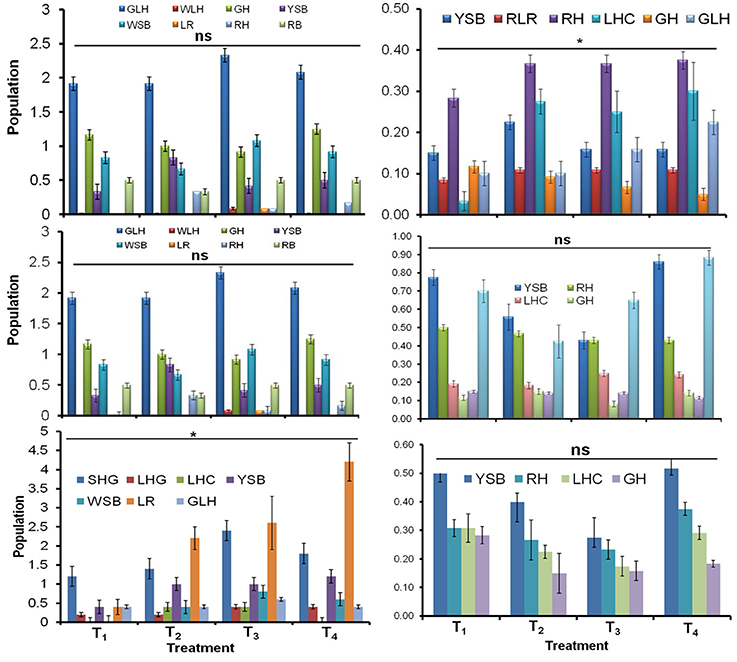
Figure 1. Effect of different treatments on the incidence of insect pests in rice field in 2014. Left panel for Rangpur and right panel for Barisal. Upper, middle, and lower figure represent Aus, Aman, and Boro seasons, respectively. Error bars indicates standard errors. T1 = Prophylactic use of insecticide, T2 = Perching and simultaneously used sweeping and need-based insecticide application, T3 = Perching, and T4 = Farmers practice. GLH, Green leafhopper; WLH, white leafhopper; GH, grasshopper; YSB, yellow stemborer; WSB, white stemborer; LR, rice leafroller, RH, rice hispa; RB, rice bug; LHC, long horned-cricket; SHG, short-horned grasshopper; LHG, long-horned grasshopper. *Significantly different at 5% level (Tukey's post hoc test); ns, not significantly different at 5% level (Tukey's post hoc test).
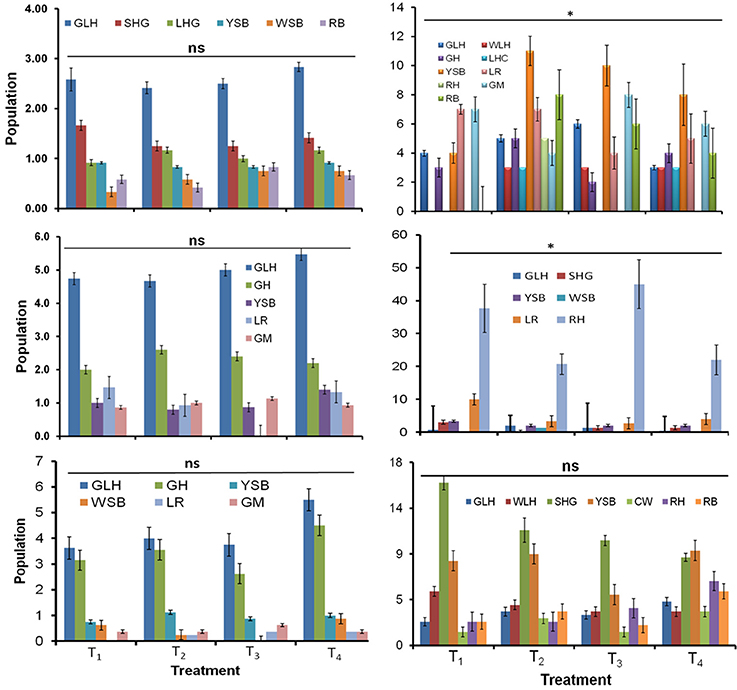
Figure 2. Effect of different treatments on the incidence of insect pests in rice fields in 2015. Left panel for Rangpur and right panel for Barisal. Upper, middle, and lower figure represent Aus, Aman, and Boro seasons, respectively. Error bars indicates standard errors. T1 = Prophylactic use of insecticide, T2 = Perching and simultaneously used sweeping and need-based insecticide application, T3 = Perching, and T4 = Farmers practice. CW, caseworm; GLH, Green leafhopper; WLH, white leafhopper; GH, grasshopper, YSB, yellow stemborer; WSB, white stemborer; LR, rice leafroller; RH, rice hispa; RB, rice bug; GM, gallmidge; LHC, long horned-cricket; SHG, short-horned grasshopper; LHG, long-horned grasshopper. *Significantly different at 5% level (Tukey's post hoc test); ns, not significantly different at 5% level (Tukey's post hoc test).
During the year 2015, recorded insect pest populations are presented in Figure 2. This year, infestation levels were also below the ETL, each season at both locations except Transplated Aman, season at Barisal region. The treatments did not show any significant different at 5% level. However, higher insect pest populations were found in Barisal region than that of Rangpur, at each season (Figure 2). At 2015, the insect infestation in Barisal region was also below the ETL at experimental plots. Yellow stem borer (YSB) is the principal insect pest that causes the most application of insecticide in rice field. YSB was recorded by sweeping and hill counting. No significant differences were observed for insect infestation among the treatments. Damaged symptom, dead heart (caused by YSB) was calculated in different treatments treated field and significant difference was not found among the treatments (p > 0.05). More or less similar scenarios were also observed by sweeping data. During Transplated Aman rice growing season, when rice fields were infested by rice hispa, Dicladispa armigera (Olivier) (Figure 3) and exceeded the ETL (counts ranged between 6 and 161 insects /20 sweeps) in all treatments at Barisal region, an insecticide was applied to control them. One application of chemical insecticide (Dimethoate 20EC at 1.0 k g/ha) was done to control rice hispa during Transplated Aman season in Barisal. Other T1 plots were also infested by rice hispa and farmers applied 2–3 times insecticides to control them, but T2 experimental plot needed only one application for successful management of rice hispa. This result indicates that need-based application of insecticides can reduce production cost (Supplementary information, Tables S1, S2). Moreover, use of chemical pesticides will be reduced from rice fields, preventing environmental degradation by unnecessary chemical pesticide.
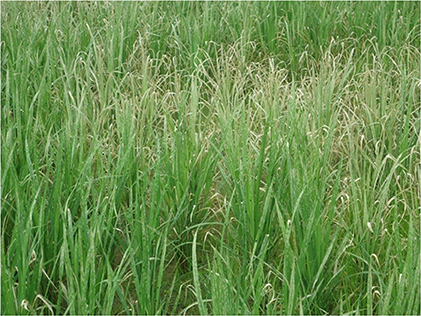
Figure 3. Rice hispa (Dcladispa armigera) infested rice plot during vegetative stage. Dimethoate® 20EC was applied for rice hispa control (one time).
Natural Enemies of Rice Insect Pests
Several common predators of Bangladesh rice fields include the dragon fly, damsel fly, spiders, lady bird beetle, staphylinid beetle, and the carabid beetle. For 2014, experimental results were demonstrated in Figure 4. Predator populations varied significantly between T1, T2, T3, and T4 treatments at Rangpur during Boro season (p < 0.05). Comparatively, higher predatory populations were found in the Rangpur region than in the Barisal region each season (Figure 4). Higher populations were found in T2 and T3 treated plots compared to the T1 and T4 treatment plots. Recall that both T1 and T2 plots were treated by insecticides, but the T2 plots were treated only as needed. Among the three seasons for rice production between the two years, higher populations were observed during the Boro season at both locations. During the 2015 rice growing season, higher predatory populations were recorded at the Barisal region than at Rangpur, at every rice production season (Figure 5). Thus, the samples indicate that phrophylactic use of insecticide has detrimental effects on the populations of natural enemies. The refrained usage of insecticide during the early crop stages (30–40 DAT), results in higher numbers of spider, lady bird beetles, and carabid beetle populations in T2 treated plots, reducing pest populations and keeping them below the ETL level.
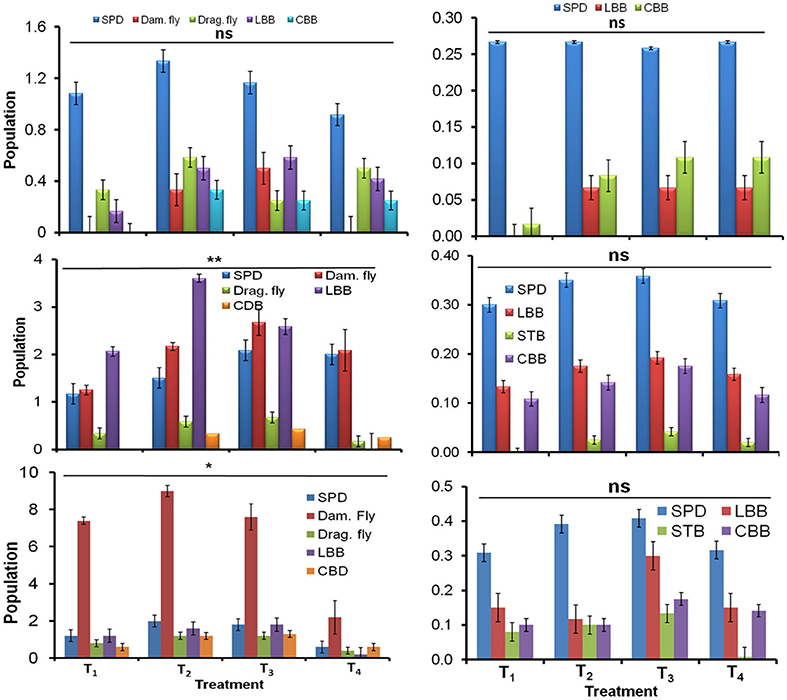
Figure 4. Effect of different treatments on the incidence of predators in rice fields in 2014. Left panel for Rangpur and right panel for Barisal. Upper, middle, and lower figure represent Aus, Aman, and Boro seasons, respectively. Error bars indicates standard errors. T1 = Prophylactic use of insecticide, T2 = Perching and simultaneously used sweeping and need-based insecticide application, T3 = Perching, and T4 = Farmers practice. SPD, staphylinid beetle; Dam. Fly, damsel fly; Drag.fly, dragon fly; LBB, ladybird beetle; CBB, carabid beetle. *Significantly different at 5% level (Tukey's post hoc test); ns, not significantly different at 5% level (Tukey's post hoc test); **Significantly different at 1% level (Tukey's post hoc test).
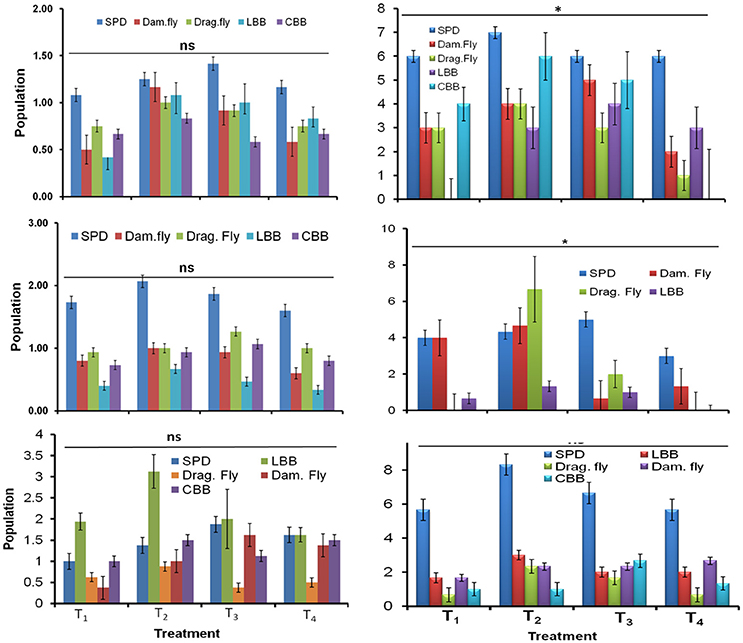
Figure 5. Effect of different treatments on the incidence of predators in rice fields in 2015. Left panel for Rangpur and right panel for Barisal. Upper, middle, and lower figure represent Aus, Aman, and Boro seasons, respectively. Error bars indicates standard errors. T1 = Prophylactic use of insecticide, T2 = Perching, and simultaneously used sweeping and need-based insecticide application, T3 = Perching and T4 = Farmers practice. SPD, staphylinid beetle; Dam. Fly, damsel fly; Drag.fly, dragon fly; LBB, ladybird beetle; CBB, carabid beetles. *Significantly different at 5% level (Tukey's post hoc test); ns, not significantly different at 5% level (Tukey's post hoc test).
Grain Yield and Pesticide Use
The rice grain yield results after harvest are summarized in Figure 6. Evidence of significant effects of the different treatments on rice growth and grain yield were not found except in Aus and Aman seasons at 2014 in the Barisal region. However, higher grain yields were observed in the Boro season at both locations in each year. Only significant effects of treatments were found at Aus (p < 0.011, F = 7.389) and during Aman seasons (p < 0.008, F = 8.332) at 2014 in the Barisal region. However, experimental plots during the Boro season at Rangpur showed higher yield than that of the Barisal region each year. In T1 and T4 treatments insecticides were applied 3-4 times in each season at both locations at each year, but significant gains of yield, due to insecticide application, were not found between T1 and T2. Regardless, insecticide usage polluted the environment, and threatened human and animal health. Our experimental results show that practicing the T2 and T3 strategies for rice production systems reduced insecticide use 75% even when the field was infested with insect pests (need based application) and reduced 100% insecticides if the field did not significantly exceed the ETL (Figure 7). The Benefit cost ratio (BCR) was also calculated, and both T2 and T3 management strategies showed higher BCR values than the other treatments (T1 and T4 Tables S1, S2).
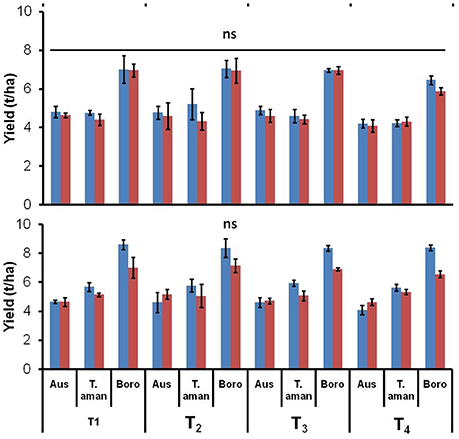
Figure 6. Effect of different treatments on rice yield. Upper figure for Rangpur and lower figure for Barisal. Blue and red bar represents the years 2014 and 2015, respectively. Error bars indicates standard errors. T1 = Prophylactic use of insecticide, T2 = Perching and simultaneously used sweeping and need-based insecticide application, T3 = Perching, and T4 = Farmers practice. SPD, staphylinid beetle; Dam. Fly, damsel fly; Drag.fly, dragon fly; LBB, ladybird beetle; CBB, carabid beetles. ns, not significantly different at 5% level (Tukey's post hoc test).
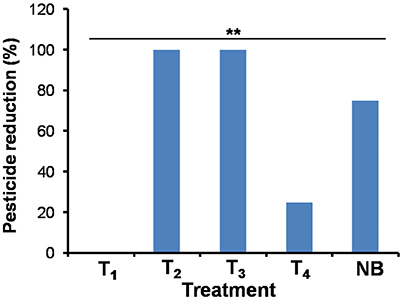
Figure 7. Effect of different treatments on the reduction of insecticide useage in rice field. T1 = Prophylactic use of insecticide, T2 = Perching and simultaneously used sweeping and need-based insecticide application, T3 = Perching, T4 = Farmers practice and NB = Need based application of insecticide augmented with T2 treatment, so NB also represents T2 when infestation exceeded the ETL in the figure but in this figure T2 represents when infestation did not cross the ETL. **Significantly different at 1% level (Tukey's post hoc test).
Discussion
Rice has a long history toward feeding people around the globe and has been cultivated by humans for over 5,000 years. Over time, scientists have invented several efficient techniques of coping with environmental conditions, including insect pests, which threaten rice production. With the arrival of modern chemical pesticides, these material are provided to farmers as the remedy for pest control, and as ways to save labor, and increase yield per unit area. However, prophylactic chemical pesticide applications come with costs of environmental degradation, risk to animal, and human health, imbalanced biodiversity, and declined crop resilience. However, farmers in Bangladesh at the first did not care for the applications of insecticide in rice fields. But, then some chose to use insecticides routinely or either if an infestation level exceeded an ETL or not. Sometimes, they got advice from pesticide dealers and too frequently applied insecticides in their fields. Thus, to reduce some of the adverse impacts, integrated pest management (IPM) is developed as a sustainable pest management system which plans to blend traditional, need-based pest-control methods and promote judicious use of pesticides. The aim is to enhance yields, improve crop resilience, and reduce damage to environmental systems associated with the excessive, indiscriminate usage of chemical pesticides.
A well planned pest management system enhances ecosystem services and supplies appropriate food sources for a wide number of natural enemies (Hillocks and Cooper, 2012). Sustainable rice agro-ecosystems provide a diverse insect community by maintaining a complex food web (Redfern et al., 2015). The insects persisting in this food web system can help provide a functional ecosystem as long as natural enemy complexes are continually enhanced (Allara et al., 2012). Rice ecosystems are inhabited by hundreds of arthropod species which perform various ecological functions such herbivory (feeding on the rice plants), predation, parasitization, pollination, decomposition, and nutrient cycling. Predator insect species account for 64.74% of all insects, with the remainder classified as pest species (Lou et al., 2013), in Bangladesh rice systems. When pesticides are made available to farmers too commonly, the beneficial animals (including earthworms or nematodes that help increase soil fertility) such as spiders, predators, parasitoids, parasites, beetles, birds, frogs and lizards are reduced under excessive pesticide use (Dutcher, 2007; Ali, 2014). The pest management approach commonly practiced by farmers often exceeds the judicious use of pesticides (that is, they use 3–4 times too much pesticide), which results in the decline in natural enemies and increases pest populations to cause damage to crop yield (Abrol, 2013). Our study results show that rice yield was not significantly higher in the T2 treatment as compared with the T4 treatment, where farmer owned plots often applied pesticide too much (Table S2). However, our study generated message that following IPM in rice farm reduces pesticide useage in crop field.
We did not find any significant differences in insect pest number in instances where the treatment involved insecticides applied 3–4 times in a rice growing season compared with those treatments that did not use insecticides in both years and at both locations. These findings indicate that without application of insecticide increases the number of natural enemies' impact on pest populations. Rice ecosystems can harbor up to 375 species of natural enemies to naturally keep in check pests (Bari et al., 2015). Rice fields without pesticides, especially during early establishment of rice plants (up to 30–40 DAT), increase natural enemies number such that they definitely attack pests (BRRI, 2015).
Variation in number among the two locations, rice production seasons, and years might be due to choice of sampling methods. Different sampling methods were used to record insect pests in Barisal, during 2014, over the rice production seasons. In Rangpur, insect pest were recorded by the sweeping method; whereas, the 20 hill counting method was used in Barisal. These two methods are highly different and sweeping often catches higher number of insects than the 20 hill counting method (BRRI, 2015). We always recommend two methods for recording insect pests from rice field but due to shortage of man power we used one method to collect data from Barisal. During the 2015 rice growing seasons, higher number of insect pests were documented in Barisal among them (Figure 2). These variations in numbers possible arose due to the location effect. Ecosystem assemblage, climatic conditions, and cropping patterns between the two locations is different. Comparatively warmer climate prevails in Barisal which can favor insect populations more so than at Rangpur. The climatic weather of Rangpur is comparatively cooler than the Barisal region in Bangladesh. In winter season sometimes temperature differed by 4–5°C between Barisal and Rangpur.
We determined the ETL in each rice field, at each season, before choosing to use insecticides in any rice field. These results indicate that use of an ETL to avoid unnecessary insecticide applications can enhance predatory populations in rice fields. We applied ETL-based insecticides strategically, as part of the T2-treated plots, to minimize pest populations. As a result rice yield was at par with other treated plots, but with the benefits that the amount of insecticide used, along with their associated cost, was reduced significantly. We found that the need-based use of pesticide is the best pest management strategy to control pests in rice fields, and reduce as well pesticide use on smallholder, agricultural farms.
The T2 treatment is also known as the IPM-treated plot, because in this system sweeping, perching and need-based (ETL based) application of insecticide was done. An IPM strategy allows ETL-based application of insecticide to be an effective technique for controlling insect pests (Abrol, 2013). In our study, when we identified a significant number of insect pests attacking a rice field, we used the pre-determined ETL to apply insecticide. During the Transplanting Aman season during 2015 in the Barisal region, a field was highly infested with rice hispa (Figure 6). The ETL of rice hispa is 35% leaf damage (BRRI, 2011), and in this field, that level was exceeded (Table S1). Sweeping was done throughout the field and Dimetheoate (20 EC at 1.0 kg/ha) was applied to control the rice hispa. This pest was properly controlled, and the final yield was harvested at a good yield on par with other nearby treatments (Table S1). The experiment was conducted jointly with farmers so they were always with us at every activity from transplanting to harvesting stage of crop. Farmers were very happy to see the results in the T2 experimental plots at harvesting time.
In T1 and farmers own treated plots (T4), also infested with rice hispa, results indicate that routine, or too frequent applications below an ETL, for a specific pest does not stop the outbreak of other pests in field. Moreover, these practices may induce outbreaks of other rice pests by disrupting natural enemy activity. Insecticides induce the outbreaks of secondary pest (Pemsl et al., 2011) and affect natural enemy abundances in fields (Dutcher, 2007).
Other studies have also demonstrated that IPM strategies, like that of T2 in this study, do not result in any yield penalty (Sattar et al., 2004; Alam, 2013). Our management system (T2) showed that a well-designed pest management program can control insect pests in an ecological manner (Bux et al., 2013; Ehi-Eromosele et al., 2013, improving overall environmental quality USEPA, 2015). Rodrigo et al. (2013) reported that recommended insecticide application compatible with IPM practices are beneficial for the control of rice pests at any stage of crop.
Pretty and Bharucha (2015) reported IPM projects, and found that at least 50% of pesticide use is not needed in most agroecosystems and sometimes resulted in a transition to zero pesticide use. Our study demonstrates that IMP significantly reduced the pesticide use or sometimes did not require using pesticide in rice production. Promotion of this practice in rice production may discourage rice farmers from use of pesticides in Bangladesh. In Sri Lanka, Costa Rica and Nicaragua, 4–7% farmers suffer bad-health from agricultural pesticide each year (Athukorala et al., 2010). Pingali and Roger (1995) estimated the human health costs of pesticide use in irrigated rice systems of the Philippines, and compared the economics of three pest control strategies: complete protection comprising nine sprays per season, economic threshold decisions involving two sprays per season, and IPM with no pesticides. It is recommended “the value of crops lost to pests is invariably lower than the cost of treating pesticide-related illness and the associated loss in farmer productivity (Pingali and Roger, 1995). Considering human health costs, IPM is the most profitable pest management strategy. Our trials (use IPM practice) resulted in pesticide reduction and improve benefit-cost ratio as compared to farmers practice. Therefore, practicing IPM approaches that reduce pesticide use in rice farm in Bangladesh will thus have important effects on rural public health.”
Rice fields need to be monitored at 7–10 days interval for checking levels of pest infestation. Field monitoring helps farmers best control their rice pests. Refraining farmers from applying insecticides to rice fields before 30-40 DAT enhances natural enemy activity to check the build-up of pest populations. Practicing need-based application of insecticide also significantly reduces total pesticide usage in rice fields. Based on this experiment, it is concluded that farmers should avoid prophylactic measures, and rather farmers monitor their crop fields at 7–10 day intervala up to the flowering stage. These practices reduce pesticide use from agricultural landscapes and improve environment quality.
Author Contributions
NA, Execute the plan and manuscript writing; SH, Manuscript writing, field experiment; MB, Field experiment, data analysis, manuscript writing; MA, Field experiment, data analysis, manuscript writing; MK, Field experiment, manuscript writing; SA, Data compilation, collection; MZ, Editing and interpreting the manuscript; JW, Writing and editing the language.
Conflict of Interest Statement
The authors declare that the research was conducted in the absence of any commercial or financial relationships that could be construed as a potential conflict of interest.
Acknowledgments
The present research is supported by the Integrated Agricultural Productivity Project (IAPP) of BRRI part. Authors thanks to DAE personnel who are involved for selecting the farmers and for their kind help in conducting experiment. Further, thanks also extended to the farmers those who cordially provided their fields, labor, time for this research. Funder has no role for designing, data collection, analyzing, or writing manuscript.
Supplementary Material
The Supplementary Material for this article can be found online at: https://www.frontiersin.org/article/10.3389/fenvs.2017.00016/full#supplementary-material
References
Abrol, D. (2013). Integrated Pest Management: Current Concepts and Ecological Perspective. Available online at: http://www.elsevier.com/books/integrated-pest-management/abrol/978-0-12-398529-3
Ahmed, N., Englund, J.-E., Åhman, I., and Lieberg, M., Johansson, E. (2011). Perception of pesticide use by farmers and neighbours in two periurban areas. Sci. Total Environ. 412–413, 77–86. doi: 10.1016/j.scitotenv.2011.10.022
Ahmed, N., Islam, Z., Hasan, M., and Kamal, N. Q. (2002). Effect of some commonly used insecticides on yellow stem borer egg parasitoids in Bangladesh. Bangladesh J. Entomol. 12, 37–46.
Akhtar, M. W., Sengupta, D., and Chowdhury, A. (2010). Impact of pesticides use in agriculture: their benefits and hazards. Interdiscip. Toxicol. 2, 1–12. doi: 10.2478/v10102-009-0001-7
Alam, M. Z. (2013). Survey and assessment of insect management technologies and environmental impact on rice ecosystem of Bangladesh. Intl. J. Appl. Res. Stud. 2, 1–16.
Alam, M. Z., Crump, A. R., Haque, M. M., Islam, M. S., Hossain, E., Hasan, S. B., et al. (2016). Effects of integrated pest management on pest damage and yield components in a rice agro-ecosystem in the Barisal region of Bangladesh. Front. Environ. Sci. 31:22. doi: 10.3389/fenvs.2016.00022.
Ali, M. P. (2014). Pesticide overuse: stop killing the beneficial agents. J. Environ. Ana. Toxicol. 4:223. doi: 10.4172/2161-0525.1000223
Allara, M., Kugbei, S., Dusunceli, F., and Gbehounou, G. (2012). “Coping with changes in cropping systems:plant pest sand seeds,” in FAO/OECD Workshop on Building Resilience for Adaptationto Climate Changeinthe Agriculture Sector (Rome).
Athukorala, W., Wilson, C., and Robinson, T. (2010). “Determinants of health costs due to farmers' exposure to pesticides: An empirical analysis,” in Proceedings of the 85th Annual Conference of Western Economic Association, Hilton Portland and Executive Tower, (Portland, OR)
Banerjee, A., Mukherjee, S., Rahman, F. H., and Singh, A. K. (2015). Evaluation of front line demonstrations on summer rice through an eco-friendly technology for management of yellow stem borer. Indian Res. J. Ext. Edu. 15, 179–183.
Bangladesh Bureau of Statistics (2008). Preliminary Report of Agriculture Census 2008. Dhaka: Statistics Division, Ministry of Planning. Available online at: http://www.bbs.gov.bd/WebTestApplication/userfiles/Image/AgricultureCensus/ag_pre_08.pdf?page=/PageReportLists.aspx?PARENTKEY=44
Bari, M. N., Ahmed, N., Haque, S. S., Rabbi, M. F., and Iftekharuddaula, M. K. (2015). Validation of integrated pest management practices for rice insect in North-west region of Bangladesh. Bangladesh Rice J. 19, 17–31. doi: 10.3329/brj.v19i1.25215
BCPA (Bangladesh Crop Protection Association) (2013). List of Registered Agricultural, Bio & Public Health Pesticide in Bangladesh. 142p. Available online at: http://www.bcpabd.com
Bhuiyan, N. I., Paul, D. N. R., and Jabber, M. A. (2004). “Feeding the extra millions by 2025: Challenges for rice research and extension in Bangladesh,” in Proceedings of the Workshop on Modern Rice Cultivation in Bangladesh. eds M. M. Haque, M. M., A. R. Gomosta, A. R., Mandal, M. R. (Gazipur, Bangladesh Bangladesh Rice Research Institute) 1–24.
Bottrell, D. G., and Schoenly, K. G. (2012). Resurrecting the ghost of green revolutions past: the brown planthopper as a recurring threat to high-yielding rice production in tropical Asia. J. Asia Pacific Entomol. 15, 122–140. doi: 10.1016/j.aspen.2011.09.004
Bux, M., Khan, M. H., Ahmad, N., Tofique, M., and Ismail, M. (2013). Field comparison of different rice (Oryza sativa L) genotypes for their resistance against rice stem borers (Pyralidae: Lepidoptera). Pak. J. Agri. 29, 137–145.
Dutcher, J. D. (2007). “General concepts in integrated pest and disease management” in Vol. 1 of the series Integrated Management of Plants Pests and Diseases. A Review of Resurgence and Replacement Causing Pest Outbreaks in IPM, eds A. Ciancio, K.G. Mukerji, 27–43.
Ehi-Eromosele, C. O., Nwinyi, O. C., and Ajani, O. O. (2013). Integrated Pest Management. Available online at: http://cdn.intechopen.com/pdfs-wm/42758.pdf.
Ganesh-Kumar, A., Prasad, S. K., and Pullabhotla, H. (2012). Supply and demand for cereals in Bangladesh 2010–2030, (IFPRI Discussion Paper 01186). International Food Policy Research Institute. Washington, DC. Available online at: http://www.ifpri.org/sites/default/files/publications/ifpridp01186.pdf.
Hillocks, R. J., and Cooper, J. E. (2012). Integrated Pest Management—Can it Contribute to Sustainable Food Production in Europe with Decreased Reliance on Conventional Pesticides? Online report. Available online at: http://www.eucipm.org/docs/IPM-Can-it-Deliver-DiscussionPaperNo1b.pdf
Hossain, M., Lewis, D., Bose, M. L., and Chowdhury, A. (2007). “Rice research, technological progress, and poverty: The Bangladesh case,” in Agricultural Research, Livelihoods and Poverty: Studies of Economic and Social Impacts in Six Countries, eds M. Adato, R. Meinzen-Dick (Baltimore, MD: The Johns Hopkins University Press and International Food Policy Research Institute), 294–297.
Hu, G., Lu, F., Zhai, B.-P., Lu, M.-H., Liu, W.-C., Zhu, F., et al. (2014). Outbreaks of the brown planthopper nilaparvata lugens (stål) in the yangtze river delta: immigration or local reproduction? PLoS ONE 9:e88973. doi: 10.1371/journal.pone.0088973
IRRI (2014). IRRI Web Portal. International Rice Research Institute, Philippines. Available online at: http://ricestat.irri.org:8080/wrs2/entrypoint.htm (Accessed December 8, 2014).
Islam, Z., Hossain, M., Chancellor, T., Ahmed, N., Hasan, M., and Haq, M. (2010). Organic rice-cropping in Bangladesh: is it a sustainable alternative to conventional practice! J. Environ. Sci. Nat. Res. 3, 233–238.
Islam, Z., Rahman, M. A., Barrior, A. T., Polaszek, T., Chancellor, K. L., Heong, N., et al., (2003). Diversity of arthropods in irrigated rice in Bangladesh. Bangladesh J. Entomol. 13, 1–25.
Lou, Y. G., Zhang, G. R., Zhang, W. Q., Hu, Y., and Zhang, J. (2013). Biological control of rice insect pests in China. Biol. Control 67,8–20. doi: 10.1016/j.biocontrol.2013.06.011
Miao, Y. X., Stewart, B. A., and Zhang, F. S. (2011). Long-term experiments for sustainable nutrient management in China. A review. Agron. Sustain. Dev. 31, 397–414. doi: 10.1051/agro/2010034
Nicolay, G., Dabire, R., Fliessbach, A., Glin, L., and Sissoko, F. (2015). Syprobio: Farmer-led innovation platforms to address food security, poverty alleviation and resilience to climate change in West African cotton-growing communities. Conference paper. Available online at: http://www.syprobio.net/fileadmin/documents_organicresearch/syprobio/Syprobio_Farmer_led_IP__Nicolay_AISApaper.pdf
Pemsl, D. E., Voelker, M., Wu, L., and Waibel, H. (2011). Long-term impact of Btcotton: findings from a case study in China using panel data. Int. J. Agric. Sustain. 9, 508–521. doi: 10.1080/14735903.2011.603904
Pingali, P. L., and Roger, P. A. (1995). Impact of Pesticides on Farmers' Health and the Rice Environment. Dordrecht: Kluwer Academic Press
Pretty, J., and Bharucha, Z. P. (2015). Integrated Pest Management for Sustainable Intensification of Agriculture in Asia and Africa. Insects 6, 152–182. doi: 10.3390/insects6010152
Redfern, S. K., Azzu, N., and Binamira, J. S. (2015). Rice in Southeast Asia: Facing Risks and Vulnerabilities to Respond to Climate Change. Available online at: http://www.fao.org/docrep/017/i3084e/i3084e18.pdf. News in FAO web portal.
Rodrigo, A. D. S., Eliane, D. Q., Gabriel, M. M., José, A. F. B., and Luciano, M. L. (2013). Compatibility of conventional agrochemicals used in rice crops with the entomopathogenic fungus Metarhizium anisopliae. Sci. Agric. 70, 152–160. doi: 10.1590/S0103-90162013000300003
Sattar, M. A., Alam, M. Z., and Rahaman, M. M. (2004). The farm use of pesticides at Mymensingh and the guideline of pesticide research in Bangladesh. Bangladesh J. Environ. Sci. 10, 313–317.
Tanwar, R. K., Singh, S. P., Sharma, O. P., Kanwar, V., Mukherjee, I., and Chattopadhyay, C., (2016). Large-scale IPM validation in Basmati rice (Oryza sativa) in Western Uttar Pradesh, India. Indian J. Agric. Sci. 86, 1063–1069.
Travisi, C. M., Nijkamp, P., and Vindigni, G. (2006). Pesticide risk valuation in empirical economics: a comparative approach. Ecol. Econ. 56, 455–474. doi: 10.1016/j.ecolecon.2004.06.026
USEPA, (United States Environmental Protection Agency) (2015). Agricultural Pesticides: Management Improvements Needed to Further Promote Integrated Pest Management. Available online at: http://www.epa.gov/agriculture/tipm.html.
Keywords: insect pest, crop production, insecticide, reduction, farmer's field
Citation: Ali MP, Bari MN, Ahmed N, Kabir MMM, Afrin S, Zaman MAU, Haque SS and Willers JL (2017) Rice Production without Insecticide in Smallholder Farmer's Field. Front. Environ. Sci. 5:16. doi: 10.3389/fenvs.2017.00016
Received: 01 December 2016; Accepted: 10 April 2017;
Published: 01 May 2017.
Edited by:
Mohiuddin Md. Taimur Khan, Washington State University, USAReviewed by:
Kenneth R. McPherson, United States Environmental Protection Agency, USAYearul Kabir, University of Dhaka, Bangladesh
Copyright © 2017 Ali, Bari, Ahmed, Kabir, Afrin, Zaman, Haque and Willers. This is an open-access article distributed under the terms of the Creative Commons Attribution License (CC BY). The use, distribution or reproduction in other forums is permitted, provided the original author(s) or licensor are credited and that the original publication in this journal is cited, in accordance with accepted academic practice. No use, distribution or reproduction is permitted which does not comply with these terms.
*Correspondence: M. P. Ali, panna_ali@yahoo.com
 M. P. Ali
M. P. Ali M. N. Bari
M. N. Bari N. Ahmed1
N. Ahmed1 